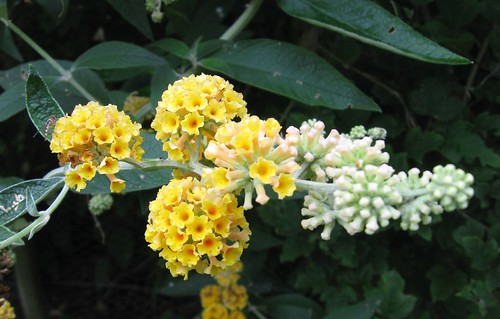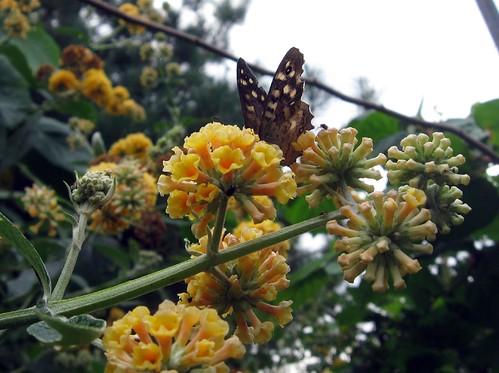I think most of us tend to think of butterflies (in temperate climes at least) as creatures of open meadow but many have evolved for forest or edge habitats and a number of these can be attracted to the garden by the use of the right shrubs, many of which can (if so desired) be incorporated into a hedge like the one we planted a few years back that I posted about last year. Plants will tend to attract butterflies for one of two reasons; either they provide food (in the form of nectar) to the butterfly itself, or they are an attractive egglaying site as they provide food for the subsequent caterpillars. We have plants in the hedge that do both.
Above is a buckthorn and I'm honestly not sure which. Both common (aka purging) buckthorn (Rhamnus cathartica) and alder buckthorn (Rhamnus frangula) were planted in the initial hedge. These plants frankly don't have much to commend them (although wikipedia tells us that the Alder Buckthorn was "of major military importance in the 15th to 19th centuries, as its wood provided the best quality charcoal for gunpowder manufacture") beyond their significance as the foodplant for the caterpillars of the fabulous, sulphur yellow Brimstone butterfly. We have seen the odd Brimstone since these went in although whether correlation equals causation in this case I can't say.
I've thrown a couple of Buddleia into gaps in the hedge too – cuttings given to us by a friend. Their form doesn't really suit hedgerow living for the most part but in our shaggy wild hedge which isn't too harshly pruned they do well. The above is a hybrid called Buddleia x weyeriana (which crosses, I think, B. davidii (the commonly seen purple, mauve or white Buddleia) with B. globosus) and as you can see it is slightly different in flower shape and very different in colour to most Buddleia. I have seen it suggested that white and yellow Buddleia are more attractive to insects than the darker coloured forms (as they are more easily seen). I haven't however seen any actual science on the subject. By way of proof that Buddleia x weyeriana is as attractive as davidii here's one with an attendant speckled wood.
![[alder]buckthorn](http://farm4.static.flickr.com/3527/3815632073_14de2b327a.jpg)


No comments:
Post a Comment